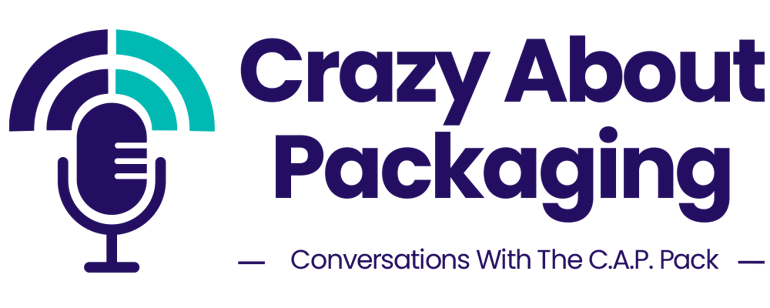
Welcome back to the Crazy About Packaging Podcast! The C.A.P. Pack is back with season 2! This season, we’re excited to take you through some of the latest innovations in packaging through conversations with industry leaders. In this month’s episode, we’ll dive into the value of a sustainable packaging assessment and the impact it has on the packaging industry.
Sneak Peek for Season 2, Episode 1
We encourage you to listen to the full podcast on Spotify, Apple, or our website. Want to see some of what we cover? Here’s a sneak peek of what to expect.
Introducing Our Guest Host: Sarah Weber
Today, we are joined by a guest host who brings passion and expertise to her role at Plastic Ingenuity: Sarah Weber. Sarah’s journey into the industry started with her education at UW Stout where she discovered her passion for packaging engineering. Initially interested in mechanical engineering, Sarah found her true calling in packaging, particularly in the medical device industry. After meeting Zach Muscato from Plastic Ingenuity (another guest host on our podcast!), she transitioned to sustainable packaging, a role that perfectly aligns with her interests in engineering and creativity. As Sarah puts it, "Packaging engineering gives me the perfect blend of creativity and technical challenge."
Can I Recycle That?
We are back with another round of “Can I Recycle That?” Natalie presents our hosts with a new challenge: can she recycle her kids’ Ritz cracker dip package?
Our hosts are no stranger to this game, but they still found themselves stumped on this package! Mike and Jonathan spent some time trying to determine its material makeup. Where did they land?
- Mike speculated the material could be either polypropylene or PET — both materials he believes could be recycled.
- Jonathan counters that it could in fact be laminate or styrene. If that’s the case, he argues, it’s not recyclable.
- Sarah, on the other hand, provides some wisdom that should be applied to any recyclables. She doesn’t know what the material is, but states her advice: "When in doubt, throw it out. If you don’t know whether it can be recycled, it’s better to throw it out to avoid contamination in the recycling stream."
Luckily, Natalie doesn’t have to guess. The packaging comes with a How2Recycle label that clearly tells her what to do with the plastic. So which of our hosts got it right? Watch the episode to find out.
Understanding the Sustainable Packaging Assessment
With that, let’s get to the meat of our conversation: what is a sustainable packaging assessment? What does it entail and why does it matter?
Sarah explains the sustainable packaging assessment (SPA) process at Plastic Ingenuity. The SPA helps customers determine the most sustainable and recyclable packaging solutions for their application by evaluating current packaging, setting goals, and creating a gap assessment. This thorough process involves design for circularity assessments, life cycle assessments, and provides actionable recommendations to meet sustainability goals.
The Sustainable Packaging Assessment (SPA) process is broken down into four steps:
- Define Customer Goals: Understand what the customer aims to achieve, whether it's designing recyclable packaging, adding recycled content, reducing carbon footprint, or lightweighting.
- Assess Current Packaging: Perform a design for circularity assessment and a life cycle assessment to understand the current impact of the packaging.
- Create a Gap Assessment: Identify what changes need to be made to meet the customer's goals and regulatory requirements.
- Execute the Plan: Work with the customer to implement the necessary changes, whether it’s redesigning the package, changing materials, or adding recycled content.
Sarah emphasized the importance of this comprehensive approach: "It's all about meeting the guidelines without being too cost-prohibitive for our customers," she noted. "We want to find solutions that are both sustainable and economically viable."
Challenges in Recycling: Healthcare Highlight
Sustainable packaging assessments are becoming increasingly important as companies are looking to be more sustainable and to meet corporate and government targets. However, implementing sustainable packaging comes with its own challenges.
One industry that has been particularly slow to adopt sustainable packaging: healthcare. Our hosts explain that much of the healthcare industry simply hasn’t been able to upgrade their recycling infrastructure — and subsequently, packaging manufacturers in the space have not worked to make their materials recyclable. It’s a vicious cycle.
"I challenge the idea that we shouldn't design for recyclability because the infrastructure isn't there yet," Sarah states. "If we don't do it right on our end, the change will never happen downstream."
Sustainable Packaging Assessments: Designing Better Packaging for the Future
Thank you for tuning into this episode of Crazy About Packaging. We hope you enjoyed learning about the value of a sustainable packaging assessment and the innovative work being done at Plastic Ingenuity.
You can listen to the full episode on our website or subscribe on Spotify or Apple. To take part in the conversation, follow us on X, LinkedIn, Facebook, and Instagram.



